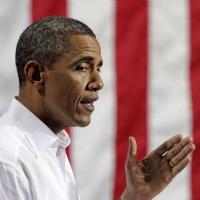BROOKE GLADSTONE:
For a historical perspective on the numbers, we turn to Robert Lichter, director of the Center for Media and Public Affairs at George Mason University. Welcome.
ROBERT LICHTER:
Thanks very much.
BROOKE GLADSTONE:
You have data on the same time frame as the Pew Study for the previous three presidents. Are the numbers negative?
ROBERT LICHTER:
All three presidents who were going to run for reelection the next year had pretty negative press in that pre-season period. George H. W. Bush, George W. Bush and Bill Clinton all had roughly two-to-one margins of bad press to good press coming up toward the primary period of election year.
BROOKE GLADSTONE:
Two to one is bad, but not as bad as Obama's four to one. But we need to keep in mind that your methodology was entirely different from Pew’s. For instance, you left out anything that had to do with the horse race. How come?
ROBERT LICHTER:
Information about the horse race is kind of a prediction but when we talk about good press or bad press, we're talking about evaluations of whether a candidate is valuable, not just whether he's politically viable.
Anytime a candidate breaks out of the pack and does well in the polls, he or she is gonna get a lot of good press. And, of course, that's happened one at a time to some of the Republican candidates.
It's also true that Candidate Obama has gotten a lot of good press for all the money he's raising for his campaign organization. So viewed as a presidential candidate, I think he would come out better than viewed as a president, overall.
BROOKE GLADSTONE:
Now, your sample size is limited only to ABC, NBC and CBS, whereas the number of news outlets Pew surveyed was orders of magnitude larger.
ROBERT LICHTER:
Nobody has ever looked at remotely as many media outlooks as Pew is doing. My hat is off to them. It's still the case that in presidential elections the broadcast networks are still very important. Four years ago what Katie Couric had to say was more important than any of the 11,000 other news outlooks that were out there.
BROOKE GLADSTONE:
But even if we take it out of the election context, and I'm gonna point you to another study that your Center for Media and Public Affairs at George Mason University did, in 2010, where you measured the three networks’ coverage of the presidents in their first seven months in office. And we're talking about Ronald Reagan, Bill Clinton, George W. Bush, Barack Obama, and also Obama on FOX. And you found that in those first seven months Ronald Reagan got 37 percent positive; Bill Clinton, 34; George W. Bush, 37; Barack Obama, 35; And Obama on FOX, 27.
ROBERT LICHTER:
Presidents used to get a honeymoon when they came into office. That had stopped for the last couple of decades. The first time a new president got a honeymoon in the last 25 years was Barack Obama. He got tremendous coverage as a presidential candidate, which everybody knows. That carried over into his first 100 days, but after that he started getting treated like any other president, which is to say, badly.
BROOKE GLADSTONE:
The media, in general, just don't like presidents, do they?
ROBERT LICHTER:
[LAUGHS] To get balanced press is a triumph for presidents.
BROOKE GLADSTONE:
Your findings have been frequently cited by groups that have criticized the media for its liberal bias. Do you see one here?
ROBERT LICHTER:
It's hard to say that there is a liberal bias when Barack Obama is getting overwhelmingly negative coverage. [LAUGHS] Presidents come in with high hopes, and he pushed the hopes higher than most. But then they just become presidents [LAUGHS] and, and they get beat up by the press.
BROOKE GLADSTONE:
All right, thank you very much.
ROBERT LICHTER:
Okay, my pleasure.
BROOKE GLADSTONE:
Robert Lichter is the director of the Center for Media and Public Affairs at George Mason University.
[MUSIC UP AND UNDER]
